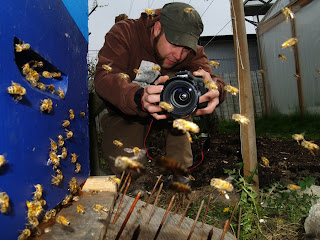
Tuesday, October 12, 2010
Wednesday, July 21, 2010
Wednesday, July 14, 2010
Monday, May 17, 2010
shiny black hairless syndrome
aka Chronic Paralysis Virus (CPV)
the saga continues,
"...has been called a variety of names - "black robbers", or "little blacks" in Britain, Schwarzucht and mal noir or mal nero in continental Europe and "hairless black syndrome" in the USA. At first the affected bees can fly, but they become hairless, appearing dark or almost black and shiny which makes them seem smaller than usual. They suffer nibbling attacks by other bees in the colony, which may account for their hairlessness and they may be prevented from returning to the colony by guard bees, which makes them appear like robber bees. In a few days they become flightless, tremble and soon die..."
"...the characteristic symptoms comprising hairless-black syndrome... high mortality and various combinations of other symptoms, such as paralysis, withdrawal from the cluster, trembling, subjection to attack by healthy bees, and the hairless-black condition."
the saga continues,
easy swarm
I love it when swarms choose low-lying branches!
at first I thought this was two swarms, but after catching the top one, the bottom group joined of its own accord, so I think they were just heavy with honey and resting on the ground:
and here they are after shaking them into a cardboard box, wagging their bums and advertising their new (temporary) home:
at first I thought this was two swarms, but after catching the top one, the bottom group joined of its own accord, so I think they were just heavy with honey and resting on the ground:
and here they are after shaking them into a cardboard box, wagging their bums and advertising their new (temporary) home:
sharing power
guess I left two queen cells in this nuc...I was surprised to see two queens, at least one of them mated (some eggs), casually sharing the same frame:
Wednesday, May 12, 2010
drone brood returns
as part of my experimental varroa mite control strategy, I removed full frames of drone brood last month and put it in the freezer. a couple days ago I gave some of the hives back of their frames, after de-capping the comb with a scratcher:
sick hive (part two)
treated for nosema last week, hard to tell if they are any better, still looks like this out front:
and even at the top of the hive, they seem a little bit jittery:
and even at the top of the hive, they seem a little bit jittery:
Friday, May 7, 2010
swarmus interruptus
I was inspecting a recently joined hive, and noticed some new queen cells, which I tore out -- and then I saw the Queen, who was piping a bit... I watched her run around the frame for a while, thinking she was a little small, yet definitely longer than a virgin.
After clearing all queen cells from the top box, I moved it (along with her) off onto the upturned lid on the grass, and then this began to happen:


I like how these girls are just chilling on the grass waiting for the swarm to make up its mind:

And I'm not sure if it's because the box was separated from the rest of the hive, or because I had torn out the queen cells, or both, but the swarm aborted and landed back in its original box:

Afterwards I moved this box aside and made a new hive -- easy split!
After clearing all queen cells from the top box, I moved it (along with her) off onto the upturned lid on the grass, and then this began to happen:


I like how these girls are just chilling on the grass waiting for the swarm to make up its mind:

And I'm not sure if it's because the box was separated from the rest of the hive, or because I had torn out the queen cells, or both, but the swarm aborted and landed back in its original box:

Afterwards I moved this box aside and made a new hive -- easy split!
forgotten queen?
Tuesday, May 4, 2010
sick hive
at first it just seemed like aggressive housecleaning, but the bee bodies kept on piling up... deeper and deeper:

observations:
-- many thousands of dead bees around the hive
-- declining hive population (duh)
-- twitching, jittery bees among the dead
-- fair number of small, shiny, black, hairless bees in the hive
-- many lethargic, pale colored bees huddled in the corners of the frame top bars (nurse bees isolating themselves perhaps?)
-- some defecation in the hive
after reviewing bee diseases, I'm thinking either nosema or chronic bee paralysis virus. I'm leaning towards CPV, yet the case for nosema is also compelling, and I have no clue how to treat CPV, so I treated them for nosema.
we'll see how it goes!

observations:
-- many thousands of dead bees around the hive
-- declining hive population (duh)
-- twitching, jittery bees among the dead
-- fair number of small, shiny, black, hairless bees in the hive
-- many lethargic, pale colored bees huddled in the corners of the frame top bars (nurse bees isolating themselves perhaps?)
-- some defecation in the hive
after reviewing bee diseases, I'm thinking either nosema or chronic bee paralysis virus. I'm leaning towards CPV, yet the case for nosema is also compelling, and I have no clue how to treat CPV, so I treated them for nosema.
we'll see how it goes!
balling
Monday, May 3, 2010
multiple eggs
Saturday, May 1, 2010
Monday, April 26, 2010
Friday, April 23, 2010
Thursday, April 22, 2010
Wednesday, April 21, 2010
Thursday, April 15, 2010
big plans
Wednesday, April 14, 2010
secondary swarms
crazy; Monday's large swarm spit out 3 secondary swarms yesterday, neatly landing on the back fence:


I didn't know what to make of it, and then I found this Wikipedia comment:
so my current theory is that the original large swarm contain four or more princesses, three of which left the next day in after-swarms of their own.
Here you can see a the virgin queen of one swarm being tended to, after I sprayed the whole bunch with water to weigh them down and make it more difficult to fly:



I didn't know what to make of it, and then I found this Wikipedia comment:
As many as 21 virgin queens have been counted in a single large swarm.
http://en.wikipedia.org/wiki/Queen_bee
so my current theory is that the original large swarm contain four or more princesses, three of which left the next day in after-swarms of their own.
Here you can see a the virgin queen of one swarm being tended to, after I sprayed the whole bunch with water to weigh them down and make it more difficult to fly:

Tuesday, April 13, 2010
kill the drones, save the hive
I'm experimenting with a new mite management technique; centralizing drone brood on a specially sized frame (drone cells are distinctly larger than worker cells), and then freezing it.
it's like a trap; varroa mites love the longer incubation period of drone brood, so by concentrating it on a single frame, the theory is that you can dramatically reduce the mite population in a hive by freezing the entire frame once it's capped.
here you can see the drone comb almost drawn:

and fully capped, ready for the freezer:

generally, honeybees produce an excess of drones, so the death of such a large portion of the drone population is not necessarily a loss for the hive...at least in terms of honey production.
it's like a trap; varroa mites love the longer incubation period of drone brood, so by concentrating it on a single frame, the theory is that you can dramatically reduce the mite population in a hive by freezing the entire frame once it's capped.
here you can see the drone comb almost drawn:

and fully capped, ready for the freezer:

generally, honeybees produce an excess of drones, so the death of such a large portion of the drone population is not necessarily a loss for the hive...at least in terms of honey production.
urban swarms
Monday, April 5, 2010
Subscribe to:
Posts (Atom)






































